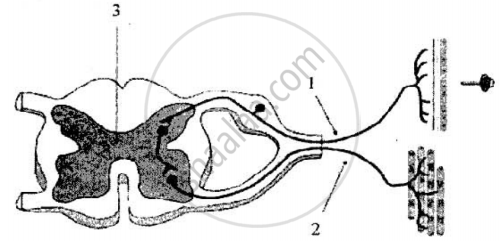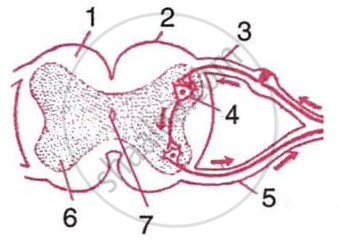Advertisements
Advertisements
प्रश्न
Which of the following cannot be considered a receptor?
(a) ear
(b) nose
(c) muscle
(d) eye
उत्तर
(c) Muscle
Sense organs contain receptors. The ear, nose and eye are sense organs, a muscle is not.
APPEARS IN
संबंधित प्रश्न
Name one gustatory receptor and one olfactory receptor present in human beings.
The diagram given below shows the internal structure of a spinal cord depicting a phenomenon. Study the diagram and answer the questions:

1) Name the phenomenon that is depicted in the diagram. Define the phenomenon.
2) Give the technical term for the point of contact between the two nerve cells.
3) Name the parts numbered 1, 2 and 3.
4) How does the arrangement of neurons in the spinal cord differ from that of the brain?
5) Mention two ways by which the spinal cord is protected in our body.
When you smell a favourite food your mouth begins to water (that is, you secrete saliva). Write down what is the example of the gland which is stimulated to secrete saliva.
Which of the following are cerebral reflexes?
(i) a person pulls away his hand on touching a hot object
(ii) a person spits out immediately when a fly enters his mouth while talking
(iii) A person walking bare foot lifts his foot at once on stepping on to a nail
(iv) A person's pupil contracts at once in the presence of bright light
(a) (i) and (ii) (b) (ii) and (iii) (c) (iii) and (iv) (d) (ii) and (iv)
Which of the following statements is correct about receptors?
The olfactory receptors in humans are located in :
(a) eyes
(b) tongue
(c) ears
(d) nose
What is a reflex action?
Mention, if the following statement is True or False
A reflex action is a spontaneous response to a stimulus.
How is the mode of action in beating of the heart different from reflex actions? Give four examples.
Given alongside is a partial diagrammatic representation of a certain phenomenon pertaining to the nervous system.
 |
- Name the parts numbered 1-7.
- Name the phenomenon that the diagram depicts and define it.
- Give the technical term for the point of contact between two nerve cells.
- Name the parts not shown in the diagram that should be included to complete the pathway of the phenomenon.
